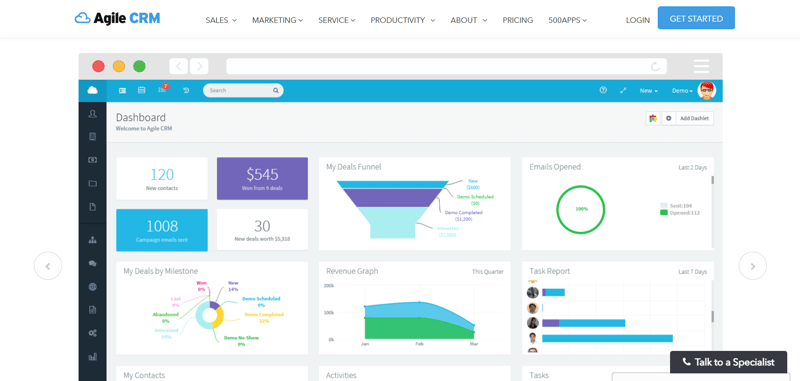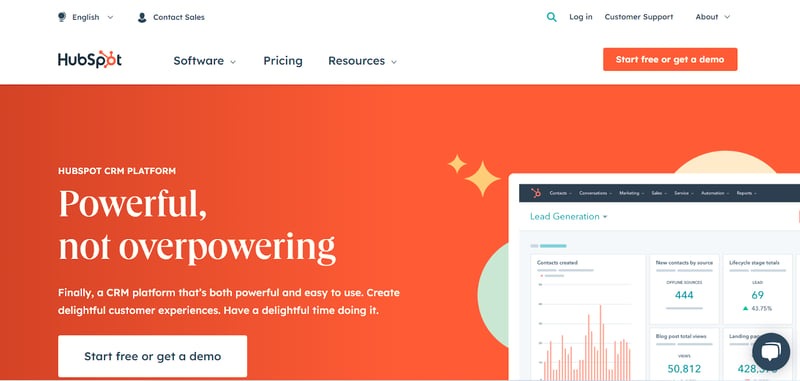
Upselling and Cross Selling [The Ultimate Comparative Guide]
 Updated on
Updated on
By Ringy
Table of Contents
Table of Contents
There's no question that upselling and cross-selling are essential sales techniques a business can employ. Not only can they increase revenue with existing customers, but they also help to cultivate customer loyalty.
This is especially important, considering that acquiring a new customer can cost a business five times more than retaining an existing one. To put it in simple terms, upselling and cross-selling are vital to keeping your customers happy, as well as increasing your profits.
But what exactly is the difference between upselling and cross-selling? And why should you be utilizing both for maximum sales potential? We're here to answer all those questions and more in this upselling and cross-selling guide.
Ready to up your upselling and cross-selling knowledge? Let's dive in!
What Is Cross-Selling and Upselling?
As mentioned, cross-selling and upselling are two sales strategies used to increase profits. They are both methods of getting customers to purchase additional products or services, but there is a crucial difference between them.
What is Cross-Selling?
Cross-selling is a sales strategy businesses use to encourage customers to purchase related products and services that complement the item they are already buying.
This is done by highlighting the features, benefits, and advantages of purchasing an additional product or service that adds to their current purchase.
For example, an e-commerce store selling sports equipment might cross-sell a customer purchasing a basketball with an additional ball pump or even a basketball hoop.
It's the same in the financial sector when a bank upsells its customers on other products and services such as credit cards, loans, insurance, investments, and more when customers are opening a new account.
What is Upselling?
Upselling is a sales technique that encourages customers to purchase higher-priced items, upgrades, or other add-ons to make a more profitable sale.
The upsell is typically done by providing customers with a better or more advanced product or service than what they initially intended to buy.
For example, if you were buying a laptop from an online retailer and the upsell was for a higher-end model, it would include more RAM, faster processor speeds, bigger hard drives, and more features for a higher price.
It's essential to remember upselling does not always mean higher prices. Sometimes upselling involves offering customers discounts or other incentives to make the more expensive option a more attractive purchase.
Upselling is also used in restaurants and other service-based businesses, with servers upselling customers on appetizers, desserts, drinks, etc. It's a great way to increase sales and provide customers with additional value.
Cross-Selling vs Upselling

Understanding the similarities and differences between upselling and cross-selling is essential to utilizing both strategies effectively.
|
Similarities |
Difference |
|
Both cross-selling and upselling involve offering additional products or services to customers during the sales process. |
Cross-selling is focused on selling complementary products or services, whereas upselling is focused on selling higher-priced or upgraded versions of the product or service the customer is already interested in. |
|
The purpose of both strategies is to leave the customer feeling like they got a deal, and as a result, increase the company's bottom line. |
Cross-selling aims to increase the overall value of the sale by adding additional products or services, whereas upselling aims to increase the profit margin by encouraging the customer to purchase a more expensive option. |
|
Both techniques involve identifying the needs and interests of the customer and presenting them with relevant options. |
Cross-selling introduces new products or services to customers that may interest them. In contrast, upselling is convincing customers to buy a more expensive version of the product or service they are already interested in. |
|
Salespeople must be excellent communicators and presenters to upsell or cross-sell customers successfully. |
Upsells can potentially increase revenue if done correctly by getting customers to purchase a more expensive upgrade. However, cross-sells, which are smaller items related but not necessarily better than the original purchase, generally don't result in larger profits. |
|
Both cross-selling and upselling require a focus on customer satisfaction and a willingness to offer personalized recommendations. |
Cross-selling is often seen as a way to enhance the customer's experience and build customer loyalty, while upselling is more focused on increasing profits for the business. |

Take your sales to new heights with Ringy.
Sales in a slump? Ringy gives you the tools and flexibility you need to capture leads, engage with them, and turn them into customers.
Cross Selling Techniques

With multiple customers coming in to buy a product or service, it's essential to know how to maximize your sales by cross-selling.
Here are some essential techniques you can use in cross-selling:
1. Data-Backed Suggestions
To maximize your sales through cross-selling, it's crucial to provide customers with data-backed suggestions and recommendations based on their purchase history or browsing patterns.
This way, you can suggest additional items that may interest them and increase their likelihood of purchasing. Additionally, this helps you to stay top-of-mind when they are looking for those items in the future.
CRM software can help track and analyze customer data if you're offering a service or product through your website. The insights you gain will help you to make more informed decisions when it comes to cross-sell.
2. Cross-Sell Additional Products or Services
It's important to identify the products or services customers will be interested in and offer them at the right time.
For example, if a customer wants to subscribe to your service, offer additional features or products that could benefit them. You can even sweeten the deal by offering discounts on your extra services.
It's essential to determine the relevance of the additional items or services and their value for customers before suggesting them. That way, you'll be able to ensure that your offers are in line with customers' needs and boost your sales simultaneously.
3. Educate Your Customers
Your goal is to add value, not push your customers into making a purchase they don't need or want.
According to a study by Forrester, which Intellum commissioned, 90% of companies that invested in customer education saw an increase in revenue and customer satisfaction.
By educating your customers and helping them understand why buying additional items or services can help them, you'll be able to foster customer loyalty and boost sales.
4. Pitching Ads
Ads allow you to showcase your products and services in various channels, such as social media, search engine result pages (SERPs), and other websites.
Product listings let customers quickly browse the items or services available on your website and compare different options. This helps them make an informed decision about their purchase and increases the chances of buying multiple items.
Cross Selling Strategies

Cross-selling can be a powerful tool for increasing sales, but you need to establish effective strategies to maximize its potential.
Here are some essential tips for creating successful cross-selling strategies:
1. Know Your Customers
Understanding your customers' needs, wants, and buying habits can help you create targeted campaigns that resonate with them.
You should be able to identify potential buyers in your customer base, figure out why they may be interested in a product or service related to the one they already purchased, and determine what will make them more likely to buy it.
This is another scenario where CRM software can significantly help. With the right CRM, you can track customer data, such as their preferred communication channels, interests, and responses to different cross-selling strategies.
2. Implement the Right Techniques
We've looked at four cross-selling techniques, but it's important to understand which will work best for your business.
Consider the context of each sale and find ways to integrate cross-selling into the customer's journey without disrupting it or making them feel pressured.
Some successful strategies include:
- Using customer segmentation
- Recommendations
- Rewards programs
- Cross-promotions
- Email campaigns
- Promotions on social media
It's also important to keep track of your results and adjust your cross-selling strategies accordingly. This will help you identify what's working and tweak it to make it even more effective.
3. Leverage Automation
Automating certain parts of the cross-selling process can save you time and effort while still allowing you to deliver a personalized experience for each customer.
For instance, you can set up automated emails that are sent at certain times in the customer journey, such as when they first sign up or after they've made their first purchase. These automated emails can be tailored to promote cross-selling opportunities, such as related products or services.
You can also incorporate automation into your database and tracking systems so you can keep track of customer preferences and make sure they're only receiving cross-selling suggestions that are relevant to them.
4. Identify Cross-Selling Opportunities
There are two main instances when customers are most likely to purchase additional products:
- When they're already in the buying process
- They need something related to what they've already bought
To identify these opportunities, you'll need to stay updated with the needs and preferences of your customers. Keeping track of customer data and trends will help you target the right people at the right time with relevant offers.
This is another instance where a CRM system can be beneficial. With the right software, you can set automated triggers that will alert you when it's time to cross-sell and generate personalized recommendations for each customer.
Ringy offers practical insights and analytics features to help you track and identify cross-selling opportunities. This can allow you to make more informed decisions about your marketing strategy and generate greater ROI from your cross-selling campaigns.
5. Keep Track of Results
You can use analytics tools to get a clearer picture of how customers respond to your efforts. This will give you valuable insights into which cross-selling approaches are working and which could be improved.
You can also use customer feedback to track how your cross-selling efforts are being received. If customers feel like they're receiving too many cross-selling offers or aren't relevant to them, you'll know it's time to adjust your strategies.
Cross Selling Tips

You now understand cross-selling, the techniques and strategies to use, but more is needed. You also need to know cross-selling tips to get the most out of your efforts.
Here are a few that you should consider:
1. Provide Clear Benefits
When cross-selling, you must ensure that you provide your customers with clear benefits of the product or service.
Highlight why they should purchase the additional item or subscription, ensuring that you communicate the value and potential savings in a way that resonates with them.
2. Leverage Drip Campaigns
Drip campaigns are a type of marketing where you send a series of automated emails to your customers. They're helpful for cross-selling because they can remind people about your product or service and convince them to buy it.
Creating a cross-selling strategy using automated emails can increase your sales and get more value out of each customer. You can test different drip campaign techniques to see what works best for your customers and tweak them as necessary.
3. Take Advantage of Existing Relationships
Cross-selling can also be done by leveraging existing relationships between customers and your business.
For example, if a customer has been loyal to your brand for many years, you could offer them related products or services that would benefit them. This strategy is especially effective for high-value customers who have already developed trust with your company.
You could also take advantage of customer referrals. If you have happy customers that are willing to recommend your products or services, you can offer them an incentive for their referral. This will help grow your customer base and increase sales in the process.
4. Provide Quality Follow Up
This includes thanking your customers for their purchase and providing helpful advice, such as how to get the most out of their product or service. You could also periodically check in with customers to see if they need help with other related products or services.
By providing quality follow-up, you can create a positive experience for your customers and encourage them to make additional purchases from your business.
Cross Selling Best Practices
There are a few cross-selling best practices that you should always keep in mind. These include:
| Best Practices | Description |
|
Establish Trust and Rapport |
Take the time to get to know your customer and build a relationship before cross-selling products or services. |
|
Focus on Quality |
It's better to offer fewer, higher-quality products that are more likely to be purchased. |
|
Create Targeted Campaigns |
This will ensure that your message resonates and is more likely to result in a purchase. |
|
Be Transparent |
When cross-selling, always be upfront about the products you are offering and their costs. Customers should not feel like they have been tricked into buying something too expensive or unnecessary. |
Cross-Selling Software
Cross-selling software can make it much simpler for your sales staff to cross-sell products by automating the process and providing data tracking of customer purchases.
That said, the following are good examples of cross-selling software solutions:
Ringy
.png?width=800&height=361&name=Ringy%20(1).png)
With Ringy CRM, you can quickly identify cross-selling opportunities and follow up with customers who have made purchases in the past.
You can make cross-sells more personalized with enough insights, leading to higher customer satisfaction and an increased conversion rate.
That's not all. Our automation feature also helps you automate cross-selling to save time and effort. With Ringy, you can easily set up automated messages that will go out to customers after they make a purchase.
By automating cross-selling, you can save time and ensure that your customers always get the best offers. Ringy also integrates with various popular software solutions, so you can easily sync your customer data and create an even more effective cross-selling strategy.
Agile CRM

Agile CRM is a comprehensive customer relationship management software with cross-selling capabilities.
This platform easily identifies cross-selling opportunities and suggests relevant products or services to customers. It also provides automated campaigns to help you target customers with the right offers.
Plus, Agile's data tracking and analytics capabilities make it easy to measure the success of your cross-selling efforts and adjust your strategy as necessary.
HubSpot

HubSpot CRM is a powerful customer relationship management platform that includes cross-selling tools. With this software, you can quickly generate personalized offers and coordinate follow-up activities for customers who have purchased in the past.
You can also use HubSpot to track cross-selling results, letting you identify which products or services are resonating with customers. This helps you optimize cross-selling campaigns to ensure maximum success.
It's important to keep in mind that cross-selling strategies should always be based on customer needs and preferences. Your customers should always come first, and your cross-selling efforts should focus on providing them with the best offers to meet their needs.
Up Selling Techniques
The key to successful upselling is ensuring you provide the customer with an item that adds value to their experience. Here are some tips for mastering the art of upselling:
1. Focus on Relevant Upsells
It's important for upsells always to be relevant to the item your customers want and need.
Providing upsells of related items helps demonstrate to customers that you genuinely understand their needs instead of pushing them toward something they don't need.
Customers will appreciate being offered upgrades of products and services that may benefit them instead of feeling rushed or pushed into purchasing something they don't need.
2. Use Your Customers' Language
When upselling, it's important to use language your customers can relate to. Speak in their language and describe the features of a product or service from their perspective.
Don't just rely on technical jargon - explain the benefits in terms that your customer will understand. You'll be able to better connect with your customer using their language.
3. Offer Special Discounts or Deals
Customers who are presented with special deals may be more likely to take advantage of the offer and make a purchase. Consider offering discounts on bundle packages, free shipping, or other incentives that could persuade customers to buy your upsell products.
You can also offer loyalty rewards such as points or discounts on future purchases. These incentives can be an effective way to increase customer loyalty and encourage customers to purchase additional items.
4. Bundle Your Products or Services
Consider offering bundles of related products or services for a discounted price when upselling. This encourages customers to purchase more items than they initially planned and helps you increase your sales.
Bundles also make purchasing easy for customers as they can buy multiple items in one transaction instead of looking around for individual items. By offering bundles, you can also create more value for customers.
Up Selling Strategies

Although it may seem like a hard sell initially, the goal of upselling is to help customers find the right product for their needs, not just to make a sale.
To get started with upselling, it's essential to implement the following strategies:
1. Create Compelling Ideas - Not Offers Only
Think of upselling as an opportunity to create interesting and unique ideas that your customers might not have considered.
For instance, rather than just offering a more expensive version of a product, you should pair it with another item for a special package deal. This helps to create value for the customer while also getting them interested in making a larger purchase.
2. Leverage Your Expertise
Be smart! Showcase additional features and benefits that might not be as obvious - like how a more advanced version of a product will make their lives easier or help them save money in the long run.
3. Offer Customized Solutions
Offfering customized solutions can help create a more personalized upsell experience and offer customers the chance to purchase products or services tailored to their needs.
It's also essential to ensure you provide plenty of options so customers feel they have some control over their purchases.
4. Make It Easy
Make sure your upsell offers are easy to find and understand so that customers can quickly decide if they want the extra features or services you're offering.
Also, don't forget about the customer experience. Ensure your sales process is quick and efficient, so customers don't feel like they're being taken advantage of.
Up Selling Tips
Here are a few tips for successful upselling:
1. Focus on Your Customers' Needs
We can't emphasize enough how important it is to get to know your customers. Take the time to understand customer feedback and understand their wants, needs, and purchasing behaviors. This can help you better identify which products or services are right for them.
2. Stay Knowledgeable
Make sure that your team members have a good understanding of the products and services they're selling. They should be able to explain the benefits of upgrading or purchasing additional items.
3. Present Solutions
When upselling, focus on presenting solutions rather than just selling products. Show customers how your product or service can help solve their problems or fill their needs.
4. Be Honest
Don't try to oversell your customers on something they don't need or can't afford. Upselling should always be about providing value and enhancing their overall experience with your business.
Up Selling Best Practices
Upselling is a great way to incr it correctly. Here are some valuable tips for upselling effectively:
| Best Practices | Description |
|
Focus on Quality |
Make sure that what you are offering as an upsell is of sufficient quality and value that your customers will want to purchase. |
|
Highlight the Benefits |
Explain why your upsell is a beneficial purchase and how it can improve the overall experience with your brand. |
|
Don't Overdo It |
Pick one or two strategically placed products and let customers know why it would be beneficial to upgrade their purchase. |
|
Ask for Feedback |
Upselling works best when you know what your customers want and need. Ask them for feedback on their preferences and use that information to determine which products you should offer as an upsell. |
These tips can help you create an effective upselling strategy that drives more sales and strengthens customer loyalty.
Up Selling Software

In addition to the tips mentioned above, upselling software can help you maximize sales. Upselling software allows businesses to suggest relevant products and services in a more customized way.
Using upselling software also helps businesses save time, as manually suggesting relevant products is automated. That said, the following software options are great for upselling:
The right upselling software can help drive more sales and build strong customer relationships. Try out these options to find the best one for your business needs!
Conclusion
Both upselling and cross-selling can help increase revenue, but it's essential to know when to use each to get the most out of them.
- Use upselling to encourage customers to buy a slightly more expensive product or add a service.
- Cross-selling is ideal for increasing average ticket size by getting customers to buy complementary products that go well together.
And with our CRM, Ringy, you'll have the tools and resources to maximize your upselling and cross-selling strategies.
You'll get insights into customer buying patterns, their preferred channel of communication, and automation capabilities to personalize user experiences like never before.
So, what are you waiting for? Give it a try today!

Skyrocket your sales with the CRM that does it all.
Calling? Check. SMS? Check. Automation and AI? Check. Effortlessly keep in touch with your customers and boost your revenue without limits.

Take your sales to new heights with Ringy.
Sales in a slump? Ringy gives you the tools and flexibility you need to capture leads, engage with them, and turn them into customers.
Subscribe to Our Blog
Enter your email to get the latest updates sent straight to your inbox!
Categories
Related Articles



































































































